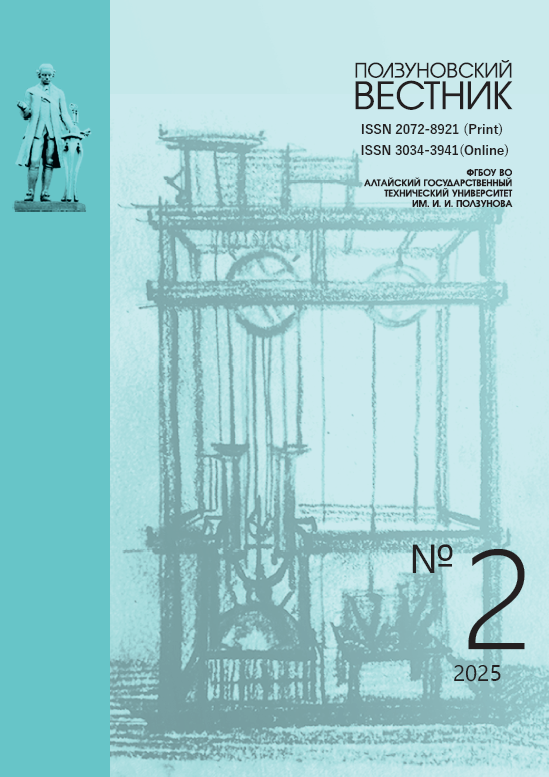PRODUCTION OF DIOPSIDE BASED ON RICE HUSK ASH BY SOLID-PHASE SYNTHESIS METHOD
VGKBHK
DOI:
https://doi.org/10.25712/ASTU.2072-8921.2025.02.025Abstract
The effectiveness of using diopside in the formulation of ceramic and other building materials, as well as for filling polymer compositions, and the simultaneous difficulties in its industrial extraction and processing make it relevant to synthesize diopside based on available starting components, for example, the carbonization product of rice production waste. At the same time, to obtain this mineral it is promising to use a fairly simple and cheap solid-phase synthesis of rice husk ash and dolomite as an accessible source of calcium and magnesium.
Optimization of the ratio of the initial components in the charge was carried out on the basis of an analysis of the phase composition of the solid-phase reaction product using the XRF method, in order to obtain the maximum diopside content of the synthesized calcium magnesium silicate. Melting was carried out for 3 hours at 1100 oC. A decrease in the temperature of solid-phase synthesis was achieved by adding flux - boric acid. It has been established that the maximum content of diopside (96%) is provided by the composition of the charge (%): flux - 5, rice husk ash - 37, dolomite - 58. The tail impurities in this case are cristobalite and ackermanite (crystalline silicon oxides). The need for a significant excess of dolomite in relation to rice husk ash is due to the fact that during the synthesis of diopside, dolomite decomposes with the release of carbon dioxide, which leads to the porosity of the resulting product, which is relatively low. A sample of the optimal composition has a fairly uniform structure, according to electron microscopic analysis.
The homogeneity of its structure is also indicated by the unimodal, relatively narrow distribution of particle sizes, the maximum number of which has a diameter of about 1 μm. Synthetic diopside has close to neutral pH values, probably due to the use of boric acid in its preparation, and low oil absorption values due to the relatively small total pore volume.
References
Верещагин В.И., Бурученко А.Е., Меньшикова В.К. Безусадочный облицовочный керамический материал на основе диопсидового сырья // Современные проблемы науки и образования. 2015. № 1–1. С. 13–19.
Верещагин В.И., Могилевская Н.В., Сафоно-ва Т.В. Спекание и прочность стеновой керамики и фаянса из композиций глинистого и диопсидсодержащего сырья // Вестник Томского государственного архитектурно-строительного университета. 2019. Т. 21. № 6. С. 122–133. doi: 10.31675/1607-1859-2019-21-6-122-133.
Исследование материалов на основе полиэфирной смолы и диопсида / В.В. Козик [и др.] // Известия высших учебных заведений. Химия и химическая технология. 2004. Т. 47. № 1. С. 112–115.
Готлиб Е.М., Ямалеева Е.С. Диопсид содержащие наполнители // Мин-во образ. и науки Рос-сии, Казан. нац. исслед. технол. ун-т. Казань : КНИТУ, 2023. 106 с.
Synthesis, phase composition and microstruc-ture of colored ceramic materials based on diopside / L. Lаkov [et al] // International scientific journal Materials science. 2020. I. 3. P. 77–79.
Rohani A.B. Production of High Purity Amor-phous Silica from Rice Husk / A.B. Rohani, Y. Rosiyah, N.G. Seng // Procedia Chemistry. 2016. V. 19. P. 189–195.
Synthesis and Characterization of Nano-Wollastonite from Rice Husk Ash and Limestone / Н. Ismail [et al] // Мaterials Science Forum. 2013. Vol. 756. P. 43–47.
A novel cost-effective approach to fabricate di-opside bioceramics / P.A. Srinath [et al] // Advanced powder technology. 2021. V. 32. No 3. P. 875–884.
Диопсид как наполнитель эпоксидных по-лимеров. / И.Д. Твердов [и др.] // Южно-Сибирский научный вестник. 2023. № 4. С. 11–15.
Способ получения диопсида: пат. 2801146 Рос. Федерация № 2022131067; заявл. 29.11.2022; опубл. 02.08.2023, Бюл. № 22. 2 10.
Vereshchagin V.I. Ceramic tiles containing diopside and clay raw materials from Khakassia / V.I. Vereshchagin // Glass and Ceramics. 2000. Vol. 57. P. 87–90. doi:10.1007/BF026815.
Готлиб Е.М., Ямалеева Е.С., Твердов И.Д., Мишагин К.А., Ха Ф.Т.Н. Применение рисовой шелухи как сырья для получения волластонит- и диопсидсодержащих наполнителей // Материалы XVIII Всероссийской научно-практической конференции с международным участием Экология родного края: проблемы и пути их решения. Киров: Изд-во: Вятский государственный университет, 2023. Т. 1. С. 418–421.
Biomineralization, antibacterial activity and mechanical properties of biowaste derived diopside nanopowders / R. Choudhary [et al] // Adv Powder Technol. 2019. Vol. 30. Is. 9. P. 1950–1964. https://doi.org/10.1016/j.apt. 2019.06.014.
Effect of Cr2O3 on Crystallization of Diopside Glass-Ceramics / Y. Wang [et al] // Crystals. 2022. Vol. 12, P. 1714. https://doi.org/10.3390/cryst12121714.
Downloads
Published
How to Cite
Issue
Section
License
Copyright (c) 2025 Ilya D. Tverdov, Elena M. Gotlib, Alina R. Valeeva, Ekaterina S. Yamaleeva

This work is licensed under a Creative Commons Attribution 4.0 International License.















 .
. This work is licensed under a
This work is licensed under a 
